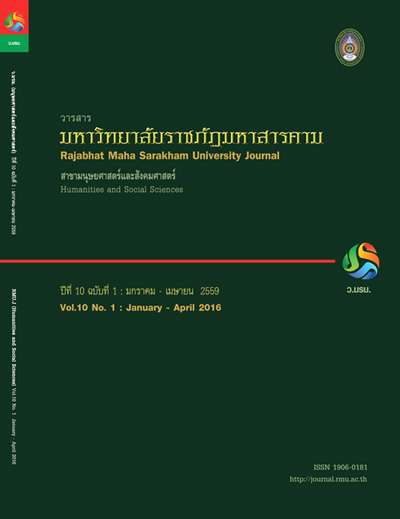การเปรียบเทียบผลการเรียนโดยใช้โปรแกรมบทเรียน เรื่อง ดนตรีไทย ของนักเรียนชั้นมัธยมศึกษาปี ที่ 1 ที่มีลักษณะการนำตนเองในการเรียนรู้ต่างกัน Comparisons of Learning Outcomes Using the Courseware Entitled Thai Music of Mathayomsuksa 1 Students with Different
Main Article Content
บทคัดย่อ
การวิจัยครั้งนี้มีวัตถุประสงค์เพื่อ 1) เพื่อพัฒนาโปรแกรมบทเรียน เรื่อง ดนตรีไทยสำหรับนักเรียนชั้นมัธยมศึกษาปีที่ 1 ที่มี
ประสิทธิภาพตามเกณฑ์ 80/80 2) เพื่อหาค่าดัชนีประสิทธิผลของโปรแกรมบทเรียน ที่ผู้วิจัยพัฒนาขึ้น 3) เพื่อเปรียบเทียบผลสัมฤทธิ์
ในการเรียน และความคิดสร้างสรรค์ ก่อนเรียนและหลังเรียน ด้วยโปรแกรมบทเรียนที่พัฒนาขึ้นของนักเรียนโดยรวมและจำแนกตาม
ลักษณะการนำตนเองในการเรียนรู้ 4) เพื่อเปรียบเทียบผลสัมฤทธิ์ทางการเรียน และการคิดสร้างสรรค์หลังเรียนด้วยโปรแกรมบทเรียน
เรื่องดนตรีไทย ของนักเรียนที่มีลักษณะการนำตนเองในการเรียนรู้ต่างกัน 5) เพื่อเปรียบเทียบความคงทนในการเรียนรู้ด้วยโปรแกรม
บทเรียนของนักเรียนที่มีลักษณะในการนำตนเองในการเรียนรู้ต่างกัน และ 6) เพื่อศึกษาความพึงพอใจของนักเรียนต่อการเรียนที่เรียน
ด้วยโปรแกรมบทเรียน กลุ่มตัวอย่างเป็นนักเรียนชั้นมัธยมศึกษาปีที่ 1 จำนวน 42 คน ภาคเรียนที่ 2 ปีการศึกษา 2555 โรงเรียนศรีวิไล
วิทยา ซึ่งได้มาจากการสุ่มแบบกลุ่ม โดยการจับสลากห้องเรียน เครื่องมือที่ใช้ในการวิจัยครั้งนี้ ได้แก่ (1) โปรแกรมบทเรียน (2) แบบ
ทดสอบวัดผลสัมฤทธิ์ทางการเรียน จำนวน 30 ข้อ (3) แบบวัดความคิดสร้างสรรค์ จำนวน 30 ข้อ (4) แบบวัดความพึงพอใจ 20 และ
ข้อ (5) แบบวัดการนำตนเองในการเรียนรู้ 40 ข้อ สถิติที่ใช้ในการวิเคราะห์ข้อมูล ได้แก่ ร้อยละ ค่าเฉลี่ย ส่วนเบี่ยงเบนมาตรฐาน
Dependent Samples t-test, และ F-test (One-way MANNOVA และ ANCOVA) ผลการวิจัยพบว่า
(1) โปรแกรมบทเรียนประสิทธิภาพเท่ากับ 85.87/84.29 (2) โปรแกรมบทเรียนมีค่าดัชนีประสิทธิผลเท่ากับ .7043 (3) นักเรียน
โดยรวมและนักเรียนที่มีการนำตนเองในการเรียนรู้สูงและตํ่าที่เรียนด้วยโปรแกรมบทเรียนมีผลสัมฤทธิ์ทางการเรียน และความคิด
สร้างสรรค์โดยรวมและเป็นรายด้านเพิ่มขึ้นจากก่อนเรียนอย่างมีนัยสำคัญทางสถิติที่ระดับ .05 (4) นักเรียนที่มีการนำตนเองในการเรียน
รู้สูงมีผลสัมฤทธิ์ทางการเรียนและความคิดสร้างสรรค์โดยรวมและเป็นรายด้าน 3 ด้านคือ ด้านความความคิดยืดหยุ่น ด้านความคิด
คลอ่ งแคลว่ และความคิดรเิ ริม่ มากกวา่ นกั เรยี นทีม่ กี ารนาํ ตนเองในการเรยี นร้ตู ำ่ (p<.0001) แตนั่กเรยี นทัง้ 2 กลมุ่ มีความคิดสรา้ งสรรค์
ด้านความละเอียดลออไม่แตกต่างกัน (5) นักเรียนที่มีการนำตนเองในการเรียนรู้สูง และ นักเรียนที่มีการนำตนเองในการเรียนรู้ตํ่า หลัง
เรียนไปแล้ว 2 สัปดาห์ มีคงทนความรู้หลังเรียนได้ไม่แตกต่างกัน (p=.703) และ (6) นักเรียนที่เรียนด้วยโปรแกรม มีความพึงพอใจ
โดยรวมอยู่ในระดับมาก
This research aimed to (1) develop a courseware entitled Thai Music for Mathayomsuksa 1 (Grade 7)
with an efficiency of 80/80 ; (2) determine an effectivesness index of the developed courseware ; (3) compare
learning achievement and creative thinking before and after learning via the developed courseware of the
students ; (4) compare learning achievement and creative thinking after learning via the developed courseware
of the students with different self-directed learning ; (5) compare learning retention of the students with different
self-directed learning ; and (6) study the students’ satisfaction with learning via the developed courseware.
The sample consisted of 42 Mathayomsuksa 1 students, attending Sliwilaiwittaya School in the second semester
of the academic year 2012, obtained using the cluster random sampling technique by selecting the classroom.
Research instruments included (1) a courseware, (2) a learning achievement test with 30 items, (3) a creative
thinking test (Figural form) with 30 items ; (4) a satisfaction questionnaire with 20 items. And (5) a self-directed
learning questionnaire with 40 items. The collected data were analyzed using a mean, a standard deviation
; and the dependent samples t-test and the F-test (One-way MANCOVA and ANCOVA) were employed for
testing hypotheses.
The major findings found that : (1) the developed courseware entitled Thai Music had an efficiency of
85.87/84.29 (2) The developed courseware had an effectiveness index of 0.7043, showing that the students
progressed their learning at 70.43 percent. (3) The students as a whole and as classified according to selfdirected
learning showed gains in learning achievement and creative thinking in general and in each subscale
from before learning via the developed courseware at the .05 level of significance. (4) The high self-directed
learning students showed more learning achievement and the creative thinking in general and in 3 subscales
: fluencing, flexibility and originality, than the low self-directed learning students at the .05 level of significance.
However, the two groups of the students did not indicate different elaboration. (5) The students with different
self-directed learning did not evidence different learning retention. And (6) the students showed satisfaction
with learning via the developed courseware as a whole at a more level.
Article Details
1. บทความที่ลงตีพิมพ์ทุกเรื่องได้รับการตรวจทางวิชาการโดยผู้ประเมินอิสระ ผู้ทรงคุณวุฒิ (Peer Review) สาขาที่เกี่ยวข้อง อย่างน้อย 3 ท่าน ในรูปแบบ Double blind review
2. ข้อคิดเห็นใด ๆ ของบทความที่ลงตีพิมพ์ในวารสารมหาวิทยาลัยราชภัฏมหาสารคาม นี้เป็นของผู้เขียน คณะผู้จัดทำวารสารไม่จำเป็นต้องเห็นด้วย
3. กองบรรณาธิการวารสารมหาวิทยาลัยราชภัฏมหาสารคาม ไม่สงวนสิทธิ์การคัดลอกแต่ให้อ้างอิงแสดงที่มา


